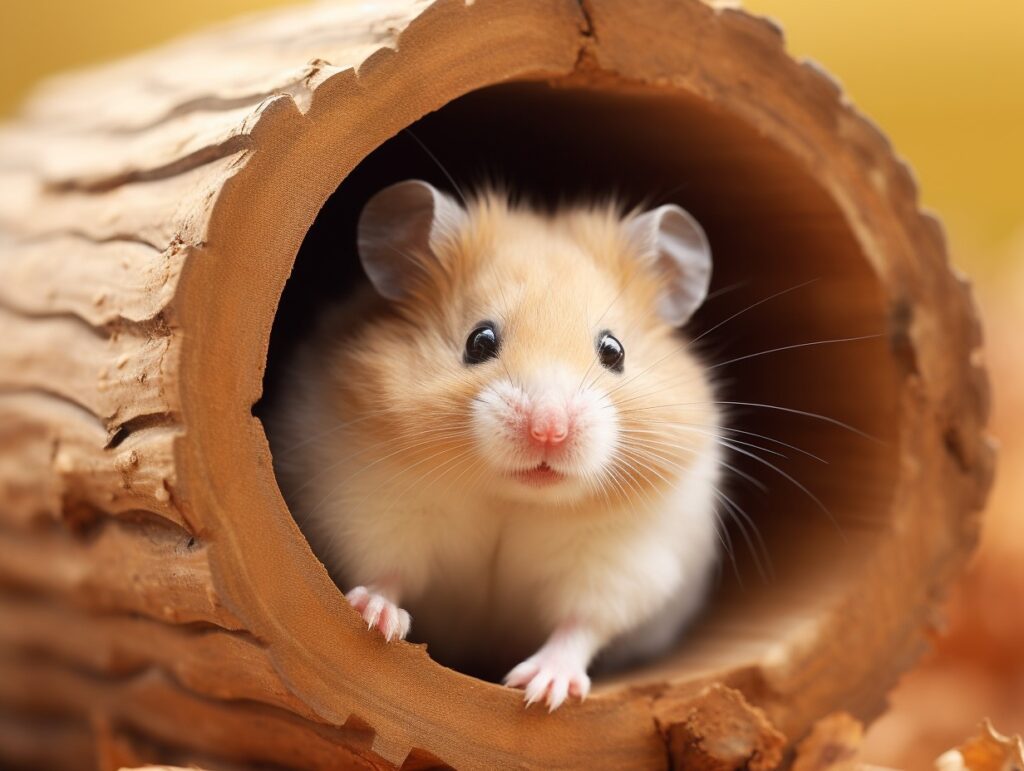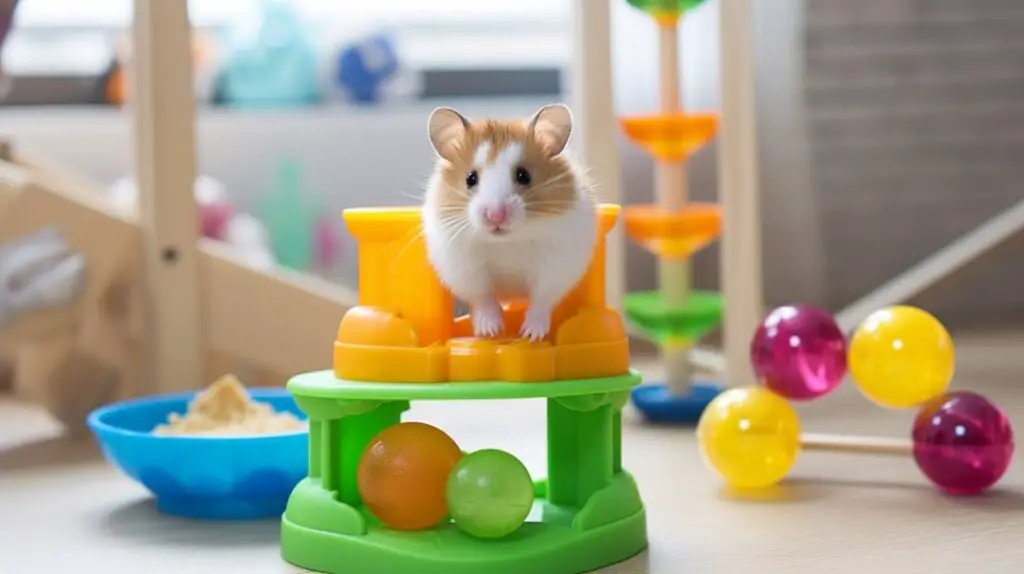
Promoting the well-being and happiness of your furry hamster friend is all about giving them plenty of fun and excitement. Toys for hamsters are the key to keeping them mentally stimulated, physically active, and stress-free. In this guide, we’ll dip into the awesome world of hamster toys, including the most popular categories, our top toy recommendations, some fun DIY options, and valuable tips to help you choose the best toys for hamsters that will keep your little buddy happy and healthy!
Key Takeaways on Toys for Hamsters
Below are the most important points when selecting great toys for hamsters:
- Opt for unpainted, untreated wood or safe plastic. Avoid toys with paint, dyes, oils, or pesticide-treated wood.
- Choose the right size for your breed – for Syrian hamsters, shop toys with diameters greater than 2 inches to avoid getting stuck.
- Include a mix of toys: tunnels/hide-outs, chews, treat puzzles, exercise wheels, digging boxes, and climbable platforms. Variety prevents boredom!
- Make sure tubes and openings are large enough for your hamster to comfortably fit through.
- Monitor toy condition and discard damaged items with exposed surfaces or sharp edges.
- Toys with multiple functions are best. Look for opportunities to encourage natural behaviors like burrowing, chewing, climbing and foraging.
- Provide new toys weekly to keep things interesting. Rotate items and make DIY toys to supplement store-bought.
- Scatter feed in toys and hide treats to stimulate foraging instincts. Place treats inside tubes or filled chew toys.
With a rotating variety of engaging toys suited to your hamster’s needs and behaviors, they’re sure to stay active!
Exercise and Activity Toys for Hamsters
Toys that encourage exercise and burn off energy are some of the most important for hamsters who love to run and play.
| Toy Type | Benefits |
|---|---|
| Exercise Wheels | Promotes physical exercise and mental stimulation |
| Hamster Balls | Provides supervised playtime outside the cage |
| Tunnels and Tubes | Encourages exploration and physical activity |
| Climbing Toys | Enhances climbing and balance skills |
| Hide-Outs | Offers comfort, security, and mental stimulation |
| Treat Dispensers | Engages foraging instincts |
| Digging Boxes | Mimics natural digging behavior |
| Chew Toys | Helps keep teeth at a healthy length |
| Homemade Hamster Toys | Affordable variety and stimulation |
Exercise Wheels
An exercise wheel is essential in every hamster cage. It’s a vital accessory that allows them to run to their heart’s content, satisfying their natural urges to tunnel and explore. Key features of a good exercise wheel include:
- Solid Surface: Ensure the wheel has a solid surface without rungs to prevent leg entrapment.
- Appropriate Diameter: For Syrian hamsters, choose a wheel with a diameter of at least 8 inches.
- Sturdy Construction: Opt for a wheel with sturdy construction that won’t wobble or tip over.
- Safety and Traction: Look for wheels with closed sides for safety and good traction.
Avoid wheels with wire bars or rungs as hamster feet and legs can get caught, leading to injuries. The safest options are those with solid plastic or metal running surfaces.
To make exercise time even more enjoyable, consider scattering some hamster food inside the wheel to encourage foraging while they exercise. You can also smear a dab of peanut butter on the inside for added incentive.
Here are some top exercise wheel picks:
- Exotic Nutrition Silent Runner Wheel
- Kaytee Silent Spinner Exercise Wheel
- Prevue Hendryx Hamster Exercise Wheel


Hamster Balls
Clear plastic hamster balls allow supervised, safe playtime outside the cage. Select a properly sized ball with ventilation holes. Supervise use to prevent injury and do not use for more than 30 minutes.
Hamster balls should not be used for young hamsters under 6 weeks old as their legs are still developing.
Recommended hamster balls:
- Kaytee Run-About Exercise Ball
- Ware Manufacturing Fun Ride Pet Ball
- Lee’s Kritter Krawler Exercise Ball
Tunnels and Tubes
Interconnected tunnels let hamsters scamper through obstacles and explore, exercising their bodies and minds. Look for:
- Durable plastic construction
- Large enough diameter for your hamster – 2.5 inch minimum for Syrians
- Removable caps for easy cleaning
- Transparent sections to watch the fun
Place tunnels and tubes at different heights – run some tunnels up ramps or levels to promote climbing.
Top tunnel and tube options:
- Kaytee Clear Connectable Habitat Tunnels
- 3 Sprouts Play Tunnel with Peek Holes
- TRIXIE Wicker Tunnel
Climbing Toys
Ramps, ladders, and platforms encourage climbing and balance skills. Just be sure ramp inclines are shallow to avoid falls. Natural wood ladders and branches work well.
Mental Stimulation Toys
Equally as important are toys that provide mental stimulation and enrichment to keep your hamster’s mind active and stave off boredom. Engaging their natural instincts is key.
Hide-Outs


Hide-outs and enclosed shelters replicate the dark burrows and tunnels hamsters build in the wild. They provide comfort, security, and mental stimulation. Offer 2+ hides per cage.
Rotate hide-outs weekly – hamsters love exploring new hides. Alternate cardboard boxes, wood hides, fabric pouches, and tunnel systems.
Recommended hide-outs and tunnels:
- Niteangel Natural Wooden Bridge Hamster House
- Niteangel Natural Wooden Tunnel System
- EcoCity Coco Hut Hamster House
Treat Dispensers and Puzzles


Treat puzzles that require hamsters to manipulate or move parts to access hidden treats engage their foraging instincts. Look for puzzles suited to your hamster’s abilities. Easy, beginner puzzles are a good starting point.
Start with easier treat puzzles and graduate to more complex, multi-step puzzles as your hamster masters them. Keep them challenged!
Starter treat puzzle ideas:
- TRIXIE Activity FlipBoard
- SunGrow Crunchy Foraging Wheel
- Kaytee Foraging Wheel
Digging Boxes
In the wild, hamsters love to dig tunnels in soft soil. A dig box allows this natural behavior. Fill a box with organic soil, coconut fiber, or aspen shavings and hide treats. Supervise to prevent eating substrate.
Offer new digging materials like shredded paper or crinkle paper bedding for variety. Always supervise to prevent the eating of substrates.
Containers to try:
- Shallow plastic storage box or bin
- Ceramic bowl
- Cardboard egg carton
Chew Toys for Hamster Teeth
Hamsters have continually growing teeth and rely on chewing to keep teeth ground down at a healthy length. Gnaw-worthy toys are a must.
Wooden Chew Blocks
Untreated wood blocks give hamsters a safe, natural chewing substrate. Hardwoods like maple hold up best. Choose large blocks wider than your hamster’s girth.
Top wooden chew blocks:
- Kaytee Lava Block Chew Toy
- SunGrow Natural Chinchilla Chew Toy
- Petsfit Wear-Resistant Natural Wooden Blocks
Chew Rings
Edible wood, loofah and vegetable fiber chew rings satisfy chewing urges and provide mental stimulation. Supervise use as pieces can break off if consumed rapidly.
Recommended chew rings:
- Care Chew Sticks
- Kaytee Nut Knot Nibbler
- Supreme Tiny Friends Farm Braided Barbells
Nuts in Shells
Hard nuts like walnuts or almonds in the shell give hamsters a challenging chewing workout. The shell keeps them working longer. Remove uneaten portions daily. Supervise closely to prevent choking or gorging.
Homemade Hamster Toys


Don’t overlook homemade hamster toys as an affordable way to provide variety and stimulation between store-bought options. Some ideas:
- Toilet paper tube tunnels – Connect tubes with small openings to crawl through
- Tissue box hide-outs – Cut doorways in shoeboxes or empty tissue boxes for safe dens
- Egg carton dig box – Fill an empty egg carton with a hamster-safe substrate for digging
- Paper bag tunnels – Paper bags folded into long rectangles or tubes make fun tunnels
- Cardboard box playhouse – Cut holes in an empty cereal box or food box and let them explore inside
- Boxes stuffed with shredded paper or fabric scraps for burrowing
- Popsicle sticks glued into ladder shapes for climbing and chewing
- Pipe cleaners twisted into balls or shapes to bat around
- Cardboard concrete forms cut into circular tunnels
- Old driftwood, sticks or untreated wood blocks from an arts store for gnawing
When making homemade toys, always use safe materials with no harsh chemicals, sharp edges, or smaller parts that can come loose. Supervise the use of all DIY toys.
Hamster Toy Safety Tips
When shopping for new hamster toys, keep these safety guidelines in mind:
- Inspect for small or removable parts that could become choking hazards
- Make sure tubes and openings are large enough for your hamster’s head and body
- Avoid toys with paint, dyes, or varnish that could contain toxic compounds if chewed or swallowed
- Monitor plastic toys for bite marks and cracks and discard damaged items promptly
- Do not use toys with sharp points or edges that could cause injury
- Verify wood toys are pesticide and chemical-free to prevent poisoning
- Check that exercise wheels and balls are appropriately sized for your breed
With a variety of enriching toys to match their needs, your hamster will stay active, engaged, and entertained for years to come!

